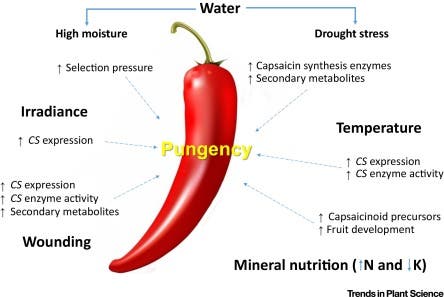It might seem odd, but spicy chili peppers and juicy tomatoes are actually related. The two plant species split off from a common ancestor nearly 19 million years ago, embarking on very different paths. Now, scientists are thinking about engineering tomatoes that are spicy for industrial applications.

The pungency (or heat) of chili peppers is due to capsaicinoids, which originate from the pith (a tissue in the stems of vascular plants). When you eat chili, the signature heat is not actually a taste — it’s pain. The molecules activate nerve cells in the tongue, which the brain interprets as a burning sensation. In a way, eating chili is like placing a hot object inside your mouth, without having to deal with the thermal damage.
Scientists believe that Capsicum plants evolved this ability in order to ward off predators, such as large mammals. Meanwhile, birds — which are seed dispersers and thus are of great use to chili peppers — show no pain response to capsaicin.
There are 23 different types of capsaicinoids, and some more pungent than others, depending on the environment for which the pepper is adapted for. Previous research has shown that capsaicinoid production is regulated by certain genes, and tomatoes — the distant cousin of chili peppers — also have these genes. They, however, lack the biological machinery to turn them on.

In a new study, researchers at the Federal University of Viçosa in Brazil are investigating the potential genetic pathways that could enable the harvest of spicy tomatoes.
“We have the tools powerful enough to engineer the genome of any species; the challenge is to know which gene to engineer and where,” senior author Agustin Zsögön, a plant biologist at the Federal University of Viçosa in Brazil, said in a statement.
There are very practical reasons for engineering a spicy tomato. These juicy berries are a lot easier to grow than chili and would produce more capsaicin per surface area due to the large volume of the fruiting body. Chili has been a prized commodity ever since it was discovered during the voyages of Christopher Columbus, which at the time fetched prices similar to gold. Today, capsaicin has been shown to have therapeutic and nutritional properties. For instance, the molecules can work as antibiotics and painkillers, and research suggests that the chili juice reduces inflammation in the gut and has antidepressant properties. They’re also used in pepper sprays.

In order to engineer spicy tomatoes, the researchers have identified various genes whose expression can be jump-started. One tool to achieve this is through the use of transcriptional activator-like effectors (TALEs), a suite of proteins secreted by pathogenic Xanthomonas spp. bacteria when they infect plant hosts. The second strategy is the use of genome engineering for targeted replacement of promoters.
“In theory, you could use these genes to produce capsaicinoids in the tomato,” says Zsögön. “Since we don’t have solid data about the expression patterns of the capsaicinoid pathway in the tomato fruit, we have to try alternative approaches. One is to activate candidate genes one at a time and see what happens, which compounds are produced. We are trying this and a few other things.”
While the main focus of such preliminary research is to produce more capsaicin at scale, such endeavors could also result in a new variety of produce in the grocery aisle. I mean, admit it, who wouldn’t try a hot tomato?






